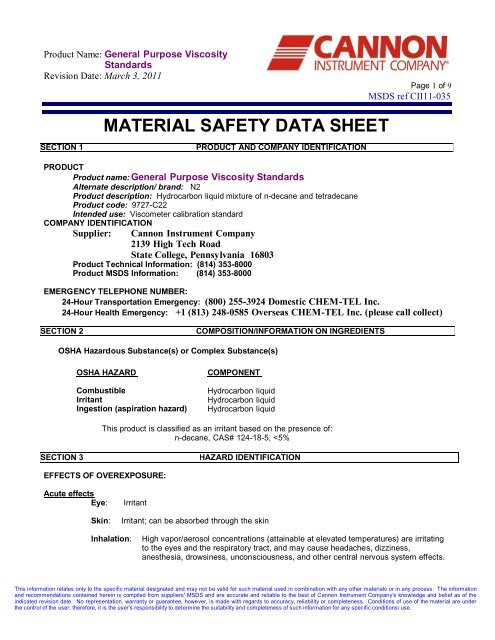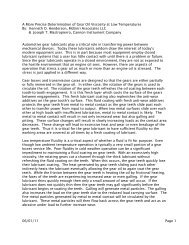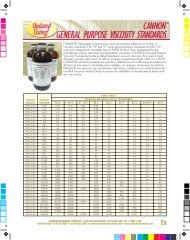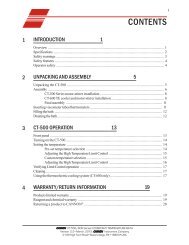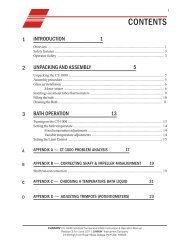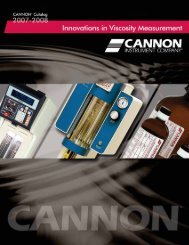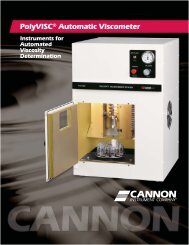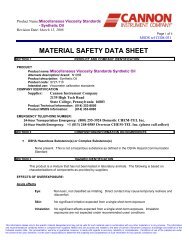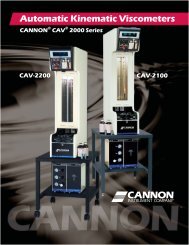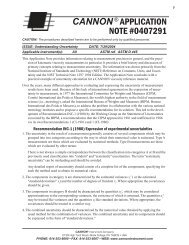N2 - Cannon Instrument Company
N2 - Cannon Instrument Company
N2 - Cannon Instrument Company
Create successful ePaper yourself
Turn your PDF publications into a flip-book with our unique Google optimized e-Paper software.
Product Name: General Purpose Viscosity<br />
Standards<br />
Revision Date: March 3, 2011<br />
Page 1 of 9<br />
MSDS ref CII11-035<br />
SECTION 1<br />
MATERIAL SAFETY DATA SHEET<br />
PRODUCT AND COMPANY IDENTIFICATION<br />
PRODUCT<br />
Product name: General Purpose Viscosity Standards<br />
Alternate description/ brand: <strong>N2</strong><br />
Product description: Hydrocarbon liquid mixture of n-decane and tetradecane<br />
Product code: 9727-C22<br />
Intended use: Viscometer calibration standard<br />
COMPANY IDENTIFICATION<br />
Supplier:<br />
<strong>Cannon</strong> <strong>Instrument</strong> <strong>Company</strong><br />
2139 High Tech Road<br />
State College, Pennsylvania 16803<br />
Product Technical Information: (814) 353-8000<br />
Product MSDS Information: (814) 353-8000<br />
EMERGENCY TELEPHONE NUMBER:<br />
24-Hour Transportation Emergency: (800) 255-3924 Domestic CHEM-TEL Inc.<br />
24-Hour Health Emergency: +1 (813) 248-0585 Overseas CHEM-TEL Inc. (please call collect)<br />
SECTION 2<br />
COMPOSITION/INFORMATION ON INGREDIENTS<br />
OSHA Hazardous Substance(s) or Complex Substance(s)<br />
OSHA HAZARD<br />
Combustible<br />
Irritant<br />
Ingestion (aspiration hazard)<br />
COMPONENT<br />
Hydrocarbon liquid<br />
Hydrocarbon liquid<br />
Hydrocarbon liquid<br />
This product is classified as an irritant based on the presence of:<br />
n-decane, CAS# 124-18-5,
Product Name: General Purpose Viscosity<br />
Standards<br />
Revision Date: March 3, 2011<br />
Page 2 of 9<br />
MSDS ref CII11-035<br />
This substance is unlikely to present a significant inhalation hazard if used for the<br />
recommended purpose.<br />
Oral:<br />
Low toxicity. Small amounts of this product aspirated into the respiratory system during<br />
ingestion or vomiting may cause severe pulmonary injury, possibly progressing to<br />
death.<br />
Prolonged/ repeated exposure effects<br />
Chronic effects<br />
None identified<br />
Signs and symptoms of overexposure:<br />
Irritation and/ or redness of eyes and skin<br />
Medical conditions aggravated by exposure<br />
None identified<br />
NFPA HAZARD ID: Health: 2 Flammability: 1 Reactivity: 0<br />
(National Fire Protection Association)<br />
NOTE: This material should not be used for any other purpose than the intended use in Section 1<br />
SECTION 4<br />
INHALATION<br />
SKIN CONTACT<br />
EYE CONTACT<br />
INGESTION<br />
FIRST AID MEASURES<br />
Using proper respiratory protection, immediately remove the affected victim from<br />
exposure. Administer artificial respiration if breathing is stopped. Keep at rest. Call for<br />
prompt medical attention.<br />
Flush with large amounts of water; use soap if available. Remove grossly contaminated<br />
clothing, including shoes, and launder before reuse.<br />
Flush eyes with large amounts of water until irritation subsides. If irritation persists, get<br />
medical attention.<br />
If swallowed, DO NOT induce vomiting. Keep at rest. Get prompt medical attention.<br />
NOTE TO PHYSICIAN: Ingested material, if aspirated into the lungs, may cause chemical pneumonitis.<br />
SECTION 5<br />
FIRE-FIGHTING MEASURES<br />
EXTINGUISHING MEDIA<br />
Appropriate extinguishing media: Carbon dioxide, foam, dry chemical and water fog. Water can be<br />
used to cool fire exposed containers<br />
FIRE FIGHTING<br />
Fire fighting instructions: Use water spray to cool fire exposed surfaces and to protect personnel.<br />
Isolate "fuel" supply from fire. Use foam, dry chemical, or water spray to extinguish fire. Avoid<br />
spraying water directly into storage containers due to danger of boilover. This liquid is volatile and<br />
gives off invisible vapors. Either the liquid or vapor may settle in low areas or travel some distance<br />
This information relates only to the specific material designated and may not be valid for such material used in combination with any other materials or in any process. The information<br />
and recommendations contained herein is compiled from suppliers MSDS and are accurate and reliable to the best of <strong>Cannon</strong> <strong>Instrument</strong> <strong>Company</strong>s knowledge and belief as of the<br />
indicated revision date. No representation, warranty or guarantee, however, is made with regards to accuracy, reliability or completeness. Conditions of use of the material are under<br />
the control of the user; therefore, it is the user's responsibility to determine the suitability and completeness of such information for any specific conditions/ use.
Product Name: General Purpose Viscosity<br />
Standards<br />
Revision Date: March 3, 2011<br />
Page 3 of 9<br />
MSDS ref CII11-035<br />
along the ground or surface to ignition sources where they may ignite or explode.<br />
Unusual fire hazards: None identified<br />
Hazardous combustion products: Thermal breakdown of this product during fire or very high heat<br />
conditions may evolve the following hazardous decomposition products: Fumes, smoke, carbon<br />
monoxide, sulfur oxides, aldehydes and other decomposition products<br />
GENERAL HAZARD<br />
Combustible Liquid can form combustible mixtures at temperatures at or above the flash point.<br />
Static Discharge: Material can accumulate static charges that can cause an incendiary electrical<br />
discharge. "Empty" containers retain product residue (liquid and/or vapor) and can be dangerous.<br />
DO NOT pressurize, cut, weld, braze, solder, drill, grind, or expose such containers to heat, flame,<br />
sparks, static electricity, or other sources of ignition; THEY MAY EXPLODE AND CAUSE INJURY<br />
OR DEATH. Empty drums should be completely drained, properly bunged and promptly returned<br />
to a drum reconditioner, or properly disposed of.<br />
FLAMMABILITY PROPERTIES<br />
Flash point °C (°F) [method]: >~65 o C (>~149 o F) [Closed Cup]<br />
Flammable limits (approx. Volume % in air): not determined<br />
Autoignition temperature °C (°F): ~200 °C (~392 °F)<br />
SECTION 6<br />
ACCIDENTAL RELEASE MEASURES<br />
NOTIFICATION PROCEDURES: Report spills/releases to appropriate authorities as required.<br />
CONTAINMENT/ CLEANUP<br />
PROCEDURES IF MATERIAL IS RELEASED OR SPILLED:<br />
LAND SPILL: Shut off source taking normal safety precautions. Take measures to minimize<br />
the effects on ground water. Recover by pumping (use an explosion proof or hand pump) or<br />
contain spilled material with sand or other suitable absorbent and remove mechanically into<br />
containers. If necessary, dispose of adsorbed residues as required by regulations (see Section<br />
13.)<br />
WATER SPILL: Confine the spill immediately with booms. Notify relevant authorities. Remove<br />
from the surface by skimming or with suitable absorbents<br />
ENVIRONMENTAL PRECAUTIONS: Prevent material from entering sewers, water sources or low lying<br />
areas; advise the relevant authorities if it has, or if it contaminates soil/vegetation.<br />
Consult an expert on disposal of recovered material and ensure conformity to local disposal<br />
regulations.<br />
PERSONAL PROTECTIVE EQUIPMENT FOR SPILLS<br />
Eyes:<br />
Skin:<br />
Use proper protection safety glasses as a minimum<br />
Washing at mealtime and end-of-shift is adequate<br />
Inhalation: No respiratory protection should be needed for small spills. For large spills, use<br />
self-contained breathing apparatus or air-purifying respiratory protection according to established<br />
local/ site emergency response procedures.<br />
This information relates only to the specific material designated and may not be valid for such material used in combination with any other materials or in any process. The information<br />
and recommendations contained herein is compiled from suppliers MSDS and are accurate and reliable to the best of <strong>Cannon</strong> <strong>Instrument</strong> <strong>Company</strong>s knowledge and belief as of the<br />
indicated revision date. No representation, warranty or guarantee, however, is made with regards to accuracy, reliability or completeness. Conditions of use of the material are under<br />
the control of the user; therefore, it is the user's responsibility to determine the suitability and completeness of such information for any specific conditions/ use.
Product Name: General Purpose Viscosity<br />
Standards<br />
Revision Date: March 3, 2011<br />
Page 4 of 9<br />
MSDS ref CII11-035<br />
Precautionary measures:<br />
Avoid eye contact. Use reasonable care<br />
SECTION 7<br />
HANDLING AND STORAGE<br />
HANDLING<br />
Keep container closed. Handle and open containers with care.<br />
ELECTROSTATIC ACCUMULATION HAZARD<br />
Yes, use proper bonding and/or grounding procedure. Additional information regarding safe<br />
handling of products with static accumulation potential can be ordered by contacting the<br />
American Petroleum Institute (API) for API Recommended Practice 2003, entitled "Protection<br />
Against Ignitions Arising Out of Static, Lightning, and Stray Currents" (American Petroleum<br />
Institute, 1220 L Street Northwest, Washington, DC 20005), or the National Fire Protection<br />
Association (NFPA) for NFPA 77 entitled "Static Electricity" (National Fire Protection Association,<br />
1 Batterymarch Park, P.O. Box 9101, Quincy, MA 02269-9101).<br />
STORAGE:<br />
Keep containers closed when not in use. Do not store in open or unlabelled containers. Store in<br />
a cool, well-ventilated place, away from strong oxidizing agents and combustible materials. Do<br />
not store near heat, sparks, flame or strong oxidants.<br />
SPECIAL PRECAUTIONS<br />
Prevent small spills and leakage to optimize housekeeping, minimize fire risk and avoid slip<br />
hazards.<br />
EMPTY CONTAINER WARNING<br />
Empty containers retain residue (liquid and/or vapor) and can be dangerous. DO NOT<br />
PRESSURIZE, CUT, WELD, BRAZE, SOLDER, DRILL, GRIND OR EXPOSE SUCH<br />
CONTAINERS TO HEAT, FLAME, SPARKS, STATIC ELECTRICITY, OR OTHER SOURCES<br />
OF IGNITION; THEY MAY EXPLODE AND CAUSE INJURY OR DEATH. Do not attempt to<br />
refill or clean container since residue is difficult to remove. Empty drums should be completely<br />
drained, properly bunged and promptly returned to a drum reconditioner. All containers should<br />
be disposed of in an environmentally safe manner and in accordance with governmental<br />
regulations.<br />
STORAGE<br />
Use reasonable care and store away from oxidizing materials<br />
SECTION 8<br />
EXPOSURE CONTROLS/PERSONAL PROTECTION<br />
EXPOSURE LIMIT VALUES<br />
None established<br />
ENGINEERING CONTROLS<br />
The use of local exhaust ventilation is recommended to control process emissions near<br />
the source. Laboratory samples should be handled in a lab hood. Provide mechanical<br />
ventilation of confined spaces. See respiratory protection recommendations.<br />
PERSONAL PROTECTION<br />
Personal protective equipment selections vary based on potential exposure conditions such as<br />
applications, handling practices, concentration and ventilation. Information on the selection of protective<br />
equipment for use with this material, as provided below, is based upon intended, normal usage.<br />
Respiratory Protection:<br />
Where concentrations in air may exceed the limits given in this Section and engineering, work<br />
This information relates only to the specific material designated and may not be valid for such material used in combination with any other materials or in any process. The information<br />
and recommendations contained herein is compiled from suppliers MSDS and are accurate and reliable to the best of <strong>Cannon</strong> <strong>Instrument</strong> <strong>Company</strong>s knowledge and belief as of the<br />
indicated revision date. No representation, warranty or guarantee, however, is made with regards to accuracy, reliability or completeness. Conditions of use of the material are under<br />
the control of the user; therefore, it is the user's responsibility to determine the suitability and completeness of such information for any specific conditions/ use.
Product Name: General Purpose Viscosity<br />
Standards<br />
Revision Date: March 3, 2011<br />
Page 5 of 9<br />
MSDS ref CII11-035<br />
practice or other means of exposure reduction are not adequate, NIOSH approved respirators<br />
may be necessary to prevent overexposure by inhalation.<br />
Hand Protection:<br />
Where contact may occur, wear long sleeves, and chemical resistant gloves, protective clothing<br />
and footwear<br />
Eye Protection:<br />
Use proper protection safety glasses as a minimum. For open systems where contact is likely,<br />
wear safety glasses with side shields. Where contact may occur, wear safety glasses with side<br />
shields.<br />
Specific Hygiene Measures:<br />
Washing at mealtime and end-of-shift is usually adequate<br />
SECTION 9<br />
PHYSICAL AND CHEMICAL PROPERTIES<br />
Typical physical and chemical properties are given below. Consult the <strong>Cannon</strong> <strong>Instrument</strong> <strong>Company</strong> as indicated<br />
in Section 1 for additional data.<br />
GENERAL INFORMATION<br />
Physical state:<br />
Form:<br />
Color:<br />
Odor:<br />
Odor threshold:<br />
Liquid<br />
Liquid<br />
Clear colorless<br />
Characteristic petroleum odor<br />
not available<br />
IMPORTANT HEALTH, SAFETY AND ENVIRONMENTAL INFORMATION<br />
Specific Gravity @ 60 o F: Lighter than water<br />
Bulk density g/cc: Not available<br />
Density, kg/m 3 (lbs./gal.): Not available<br />
Flash point °C (°F) [method]: >~65 o C (>~149 o F) [Closed Cup]<br />
Flammable limits (approx. Volume % in air): not determined<br />
Autoignition temperature °C (°F): ~200 °C (~392 °F)<br />
Ignition temperature (polymers) °C (°F): not applicable<br />
Boiling point/range °C (°F): not determined<br />
Vapor density @ 101 kPa (air =1): greater than air<br />
Vapor pressure @ 20°C, kPa (mm Hg): not determined<br />
Evaporation rate (n-butyl acetate =1): not determined<br />
pH: not applicable<br />
Log Pow (n-Octanol/water partition coefficient): not determined<br />
Solubility in water (20 °C): negligible<br />
Viscosity: See product specification<br />
OTHER INFORMATION<br />
Freezing point °C (°F):<br />
Melting Point °C (°F):<br />
Pour point °C (°F):<br />
Molecular weight:<br />
Hygroscopic:<br />
not determined<br />
not determined<br />
not determined<br />
not determined<br />
no<br />
This information relates only to the specific material designated and may not be valid for such material used in combination with any other materials or in any process. The information<br />
and recommendations contained herein is compiled from suppliers MSDS and are accurate and reliable to the best of <strong>Cannon</strong> <strong>Instrument</strong> <strong>Company</strong>s knowledge and belief as of the<br />
indicated revision date. No representation, warranty or guarantee, however, is made with regards to accuracy, reliability or completeness. Conditions of use of the material are under<br />
the control of the user; therefore, it is the user's responsibility to determine the suitability and completeness of such information for any specific conditions/ use.
Product Name: General Purpose Viscosity<br />
Standards<br />
Revision Date: March 3, 2011<br />
Page 6 of 9<br />
MSDS ref CII11-035<br />
Coefficient of thermal expansion:<br />
not determined<br />
SECTION 10<br />
STABILITY AND REACTIVITY<br />
STABILITY:<br />
Stable<br />
CONDITIONS TO AVOID:<br />
MATERIALS TO AVOID:<br />
Extreme heat and high-energy sources of ignition.<br />
Halogens, molten sulfur, strong oxidizing agents.<br />
HAZARDOUS DECOMPOSITION PRODUCTS:<br />
HAZARDOUS POLYMERIZATION:<br />
Product does not decompose at ambient temperatures.<br />
Hazardous polymerization will not occur<br />
SECTION 11<br />
TOXICOLOGICAL INFORMATION<br />
No specific toxicology data on this product have been provided by the supplier(s)<br />
SECTION 12<br />
ECOLOGICAL INFORMATION<br />
Environmental fate and distribution<br />
No specific ecological data are available for this product. Please refer to Section 6 for<br />
information regarding accidental releases and Section 15 for regulatory reporting information<br />
Environmental effects<br />
Air: No specific data are available<br />
Water: No specific data are available<br />
Soil: No specific data are available<br />
Degradation: No specific data are available<br />
Toxicity to water organisms: No specific data are available<br />
Toxicity to soil organisms: No specific data are available<br />
Bioaccumulation: No specific data are available<br />
Fate and effects in water treatment plants<br />
No specific data are available<br />
SECTION 13<br />
DISPOSAL CONSIDERATIONS<br />
Please refer to Sections 5, 6 and 15 for disposal and regulatory information<br />
WASTE DISPOSAL: Product is suitable for burning in an enclosed, controlled burner for fuel value.<br />
Such burning may be limited pursuant to the Resource Conservation and Recovery Act. In<br />
This information relates only to the specific material designated and may not be valid for such material used in combination with any other materials or in any process. The information<br />
and recommendations contained herein is compiled from suppliers MSDS and are accurate and reliable to the best of <strong>Cannon</strong> <strong>Instrument</strong> <strong>Company</strong>s knowledge and belief as of the<br />
indicated revision date. No representation, warranty or guarantee, however, is made with regards to accuracy, reliability or completeness. Conditions of use of the material are under<br />
the control of the user; therefore, it is the user's responsibility to determine the suitability and completeness of such information for any specific conditions/ use.
Product Name: General Purpose Viscosity<br />
Standards<br />
Revision Date: March 3, 2011<br />
Page 7 of 9<br />
MSDS ref CII11-035<br />
addition, the product is suitable for processing by an approved recycling facility or can be<br />
disposed of at an appropriate government waste disposal facility. Use of these methods is<br />
subject to user compliance with applicable laws and regulations and consideration of product<br />
characteristics at time of disposal.<br />
SECTION 14<br />
TRANSPORT INFORMATION<br />
Note: The information provided below may not apply to all shipping situations. Consult appropriate<br />
Dangerous Goods Regulations for additional requirements and mode-specific, material-specific, or<br />
quantity-specific shipping requirements.<br />
United States Department of Transportation (US DOT):<br />
UN/ID# Proper Shipping Name Class/Division Hazard Label(s) Packing Group<br />
Not Regulated As A Hazardous Material Or Dangerous Good For This Mode of Transportation.<br />
International Air Transport Association (IATA):<br />
UN/ID# Proper Shipping Name Class/Division Hazard Label(s) Packing Group<br />
Not Regulated As A Hazardous Material Or Dangerous Good For This Mode of Transportation.<br />
SECTION 15<br />
REGULATORY INFORMATION<br />
OSHA HAZARD COMMUNICATION STANDARD:<br />
This material is classified as hazardous in accordance with<br />
OSHA 29 CFR 1910.1200. See section 2<br />
NATIONAL CHEMICAL INVENTORY LISTING: This product, and/ or its constituents, is listed on the US EPA/<br />
TSCA (Toxic Substances Control Act) Inventory<br />
COMMUNITY RTK:<br />
Chemical Name CAS Number Typical Value Component TPQ Product TPQ<br />
n-Tetradecane 629-59-4 95 - 100% Not applicable Not applicable<br />
n-Decane 124-18-5 0 - 5% Not applicable Not applicable<br />
Clean Water Act/Oil Pollution Act:<br />
No specific information provided by the supplier(s) of this product<br />
Section 304 CERCLA HAZARDOUS SUBSTANCES:<br />
No specific information provided by the supplier(s) of this product<br />
SARA (311/312) REPORTABLE HAZARD CATEGORIES:<br />
Under the provisions of Title III, Sections 311/312 of the Superfund Amendments and<br />
Reauthorization Act, this product is classified into the following hazard categories:<br />
This information relates only to the specific material designated and may not be valid for such material used in combination with any other materials or in any process. The information<br />
and recommendations contained herein is compiled from suppliers MSDS and are accurate and reliable to the best of <strong>Cannon</strong> <strong>Instrument</strong> <strong>Company</strong>s knowledge and belief as of the<br />
indicated revision date. No representation, warranty or guarantee, however, is made with regards to accuracy, reliability or completeness. Conditions of use of the material are under<br />
the control of the user; therefore, it is the user's responsibility to determine the suitability and completeness of such information for any specific conditions/ use.
Product Name: General Purpose Viscosity<br />
Standards<br />
Revision Date: March 3, 2011<br />
Page 8 of 9<br />
MSDS ref CII11-035<br />
Irritant, fire hazard.<br />
SARA (313) TOXIC RELEASE INVENTORY:<br />
No specific information provided by the supplier(s) of this product<br />
International chemical inventories and hazard classifications<br />
This product and/ or its components are on the Canadian Domestic Substance List/ NDSL, or are<br />
otherwise in compliance with related regulations.<br />
WHMIS Classifications (Canada):<br />
This fluid, which is a mixture, is not controlled under provisions of WHMIS. However, n-decane, a<br />
minor constituent, would be controlled as a pure substance:<br />
Classification of n-decane, as a pure substance:<br />
CAS Registry Number: 124-18-5<br />
WHMIS Classification:<br />
B3 - Flammable and combustible material - Combustible liquid<br />
D2B - Poisonous and infectious material - Other effects - Toxic<br />
B3<br />
D2B<br />
WHMIS Health Effects Criteria met by this Chemical:<br />
D2B - Skin irritation - toxic - other<br />
WHMIS Ingredient Disclosure List:<br />
Not included. Meets criteria for disclosure at 1% or greater.<br />
This product and/ or its components are on EINECS (European Inventory of Existing Chemical<br />
Substances) and/ or ELINCS (European Library of Notified Chemical Substances), or is otherwise<br />
in conformance with related EU directives/ regulations.<br />
EU Hazard Classification, risk and safety phrases (Europe):<br />
This product and/ or its constituents are not classified under provisions of the European<br />
Dangerous Substances Directive or the Dangerous Preparations Directive or related regulations<br />
SECTION 16<br />
OTHER INFORMATION<br />
THIS SAFETY DATA SHEET CONTAINS THE FOLLOWING REVISIONS:<br />
Revision Summary:<br />
· October 15, 2005 -- This MSDS has been fully reviewed and reformatted to conform to changes<br />
in standard format<br />
· May 14, 2007: Added Canadian and European classification and labeling information, based<br />
on current regulations and/or recommendations from suppliers (see Section 15)<br />
This information relates only to the specific material designated and may not be valid for such material used in combination with any other materials or in any process. The information<br />
and recommendations contained herein is compiled from suppliers MSDS and are accurate and reliable to the best of <strong>Cannon</strong> <strong>Instrument</strong> <strong>Company</strong>s knowledge and belief as of the<br />
indicated revision date. No representation, warranty or guarantee, however, is made with regards to accuracy, reliability or completeness. Conditions of use of the material are under<br />
the control of the user; therefore, it is the user's responsibility to determine the suitability and completeness of such information for any specific conditions/ use.
Product Name: General Purpose Viscosity<br />
Standards<br />
Revision Date: March 3, 2011<br />
Page 9 of 9<br />
MSDS ref CII11-035<br />
· February 5, 2008 ; This MSDS was revised and reissued under a new MSDS designation<br />
(CII08-035, previously CII07-026). The earlier MSDS included a specific formulation that was<br />
required to be classified in the European Union as a hazard that does not apply to this specific<br />
formulation. CII07-026 is retained for that other formulation. This MSDS was also updated to<br />
include an NFPA health code of “1”, to reflect the irritant nature of the formulation, and to add<br />
Canadian WHMIS information on the n-decane (a minor constituent that does not affect the<br />
overall WHMIS classification of the mixture)<br />
· March 6, 2008: Updated and standardized format of Transport Information (see Section 14)<br />
· March 3, 2011: Reviewed content. Updated NFPA Hazard ID of Hazard Identification (see<br />
Section 3). Updated Flammability Properties of Fire-Fighting Measures (see Section 5).<br />
Updated Important Health, Safety, and Environmental Information of Physical and Chemical<br />
Properties (see Section 9).<br />
NOTES:<br />
This information relates only to the specific material designated and may not be valid for such material used in combination with any other materials or in any process. The information<br />
and recommendations contained herein is compiled from suppliers MSDS and are accurate and reliable to the best of <strong>Cannon</strong> <strong>Instrument</strong> <strong>Company</strong>s knowledge and belief as of the<br />
indicated revision date. No representation, warranty or guarantee, however, is made with regards to accuracy, reliability or completeness. Conditions of use of the material are under<br />
the control of the user; therefore, it is the user's responsibility to determine the suitability and completeness of such information for any specific conditions/ use.


